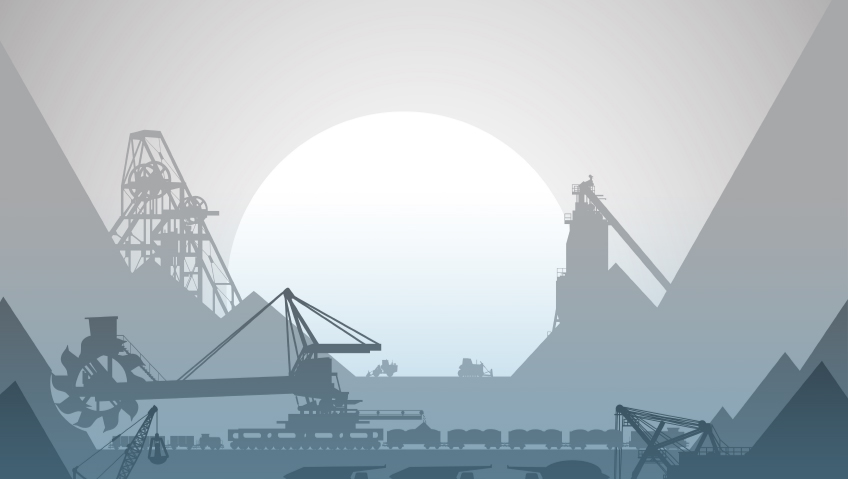As we enter the new decade, today’s resource sector companies are facing greater challenges than ever before. Mining, oil and gas, hydroelectricity, agriculture, and other industries are facing pressure to produce more while increasing profits, reducing waste, remaining cost-effective, and respecting environmental regulations. To achieve these goals and others, logistics is the key.
Automobile manufacturing is undergoing drastic changes as it moves away from internal combustion engines toward energy-efficient electric. As seen when such industries evolve, there are many logistical issues at play, from adjusting supply chains to selecting the types of materials being used in production. And as these changes increase, so does the need for many sectors to optimize their labour force.
In its simplest terms, logistics is about managing and optimizing the flow of materials and information from one point to another. In the resource arena, companies are under increased pressure to increase volumes, boost productivity, and reduce costs for everything from fuel to freight. This requires focusing on smarter supply chains and better logistics management of materials and people.
Worldwide, many businesses are facing a shortage of new workers, and mining is no exception. Seasoned staff retire every day, and many resource sector jobs are unfilled, with other positions occupied by employees in their forties and fifties. The Canadian Minerals and Metals Plan (CMMP) – designed to increase awareness of how vital the mining sector is to the nation – recently reported on the looming shortage of workers in mining, estimating approximately 100,000 more will be needed in the coming decade.
To combat this, the sector will need to see greater representation of women, minorities and Indigenous people in the workforce. It will simultaneously be reshaped by technology. Fast disappearing are the days where mining and other resource jobs were the sole domain of young, fit males, as more companies embrace driverless vehicles with on-board cameras, autonomous drill rigs outfitted with sensors and positioning devices, and advanced software enabling operator control from a distance through handheld devices.
This trend has several distinct advantages, including safety, with humans far removed from dangerous conditions like falling debris both above and below ground. Longstanding issues such as driver fatigue, from spending hours behind the wheel of trucks and other vehicles, is reduced.
Automation also helps improve the bottom line. Through robotics and other technologies, operations are much more efficient. Since fewer workers are required, labour costs are lowered, and software helps identify problem areas while increasing accountability.
Many mining companies, such as Rio Tinto, are embracing ‘smart mining.’ The 147-year-old Anglo-Australian multinational is one of the planet’s biggest mining and metals companies and is embracing technology to make operations more effective, less expensive, and safer. It uses virtual reality at its New Zealand Aluminium Smelter Limited (NZAS) and has a mine automation system, which compiles data at ninety-eight percent of its sites.
The company is behind software such as RTVis, the three-dimensional tool that can track inside its operations. RTVis is used by 1,700 workers, and its many benefits include more precise drilling and blasting using fewer explosives, as well as “better waste classification, which means that our trucks carry less waste material and more ore. This boosts productivity and lowers costs.”
As jobs in the resource sector are changing thanks to technology, workers in the future will be required to use less muscle power and more mental strength. Hands-on positions to run heavy equipment will always exist, but computer programs, robotics, automation, and other technologies will increase the need for more skilled technicians operating on-site and remotely. Man and machine will still work together, but the nature of work will keep changing. Rather than putting human lives at risk, computers will analyze potential dangers.
Already, virtual reality technology – created by South Africa’s Simulated Training Solutions – is being used to create projected ‘blast walls,’ providing on-the-job training to technicians to determine how rock faces will fracture when actually exploded. The technology has the potential to save workers from injury or death, and training mining staff this way means lower costs, reduced waste, and fewer humans required for clean-up.
Much like mining, other resource sectors – such as oil and gas – are under pressure to increase profits and do more with less. Automation will change the workforce, as physical labour is replaced by data, necessitating a new generation of computer-savvy employees familiar with cloud technology, advanced analytics, and other skills of the future.
While logistics in mining, oil and gas and others engaged in the resource sector are complex and challenging, labour must also be managed to ensure competitiveness, efficiency, and cost-effectiveness. Other factors, such as lowering costs for transportation and reducing waste, optimizing worker efficiency, and reducing downtime are vital to success.
Recent figures from the U.S. Bureau of Labor Statistics indicates labour productivity is on the rise in some resource sectors – 12.1 percent in oil and gas extraction, for example. Mining, however, saw a 3.5 percent decline in productivity, “as the increase in hours worked was larger than a modest increase in output.”
Like other industries, the resource sector will continue to attract able young labourers, but with a greater emphasis than ever before on people with sophisticated technology skills, such as data analysts, computer programmers, and software experts. And while there will always be a demand for heavy machinery operators, many of these jobs will demand a combination of hands-on experience and the tools needed to operate vehicles and equipment remotely through GPS, sensors, and other high-tech devices.






